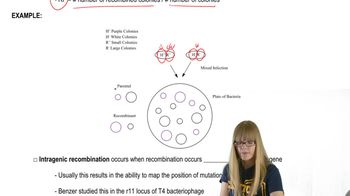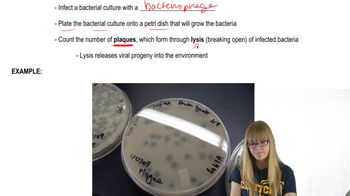Describe the differences between genetic complementation and recombination as they relate to the detection of wild-type lysis by a mutant bacteriophage.
Table of contents
- 1. Introduction to Genetics51m
- 2. Mendel's Laws of Inheritance3h 37m
- 3. Extensions to Mendelian Inheritance2h 41m
- 4. Genetic Mapping and Linkage2h 28m
- 5. Genetics of Bacteria and Viruses1h 21m
- 6. Chromosomal Variation1h 48m
- 7. DNA and Chromosome Structure56m
- 8. DNA Replication1h 10m
- 9. Mitosis and Meiosis1h 34m
- 10. Transcription1h 0m
- 11. Translation58m
- 12. Gene Regulation in Prokaryotes1h 19m
- 13. Gene Regulation in Eukaryotes44m
- 14. Genetic Control of Development44m
- 15. Genomes and Genomics1h 50m
- 16. Transposable Elements47m
- 17. Mutation, Repair, and Recombination1h 6m
- 18. Molecular Genetic Tools19m
- 19. Cancer Genetics29m
- 20. Quantitative Genetics1h 26m
- 21. Population Genetics50m
- 22. Evolutionary Genetics29m
5. Genetics of Bacteria and Viruses
Bacteriophage Genetics
Problem 14
Textbook Question
The bacteriophage genome consists of many genes encoding proteins that make up the head, collar, tail, and tail fibers. When these genes are transcribed following phage infection, how are these proteins synthesized, since the phage genome lacks genes essential to ribosome structure?
 Verified step by step guidance
Verified step by step guidance1
Understand that bacteriophages are viruses that infect bacteria and rely on the host's cellular machinery to reproduce.
Recognize that although the phage genome encodes proteins for its structure (head, collar, tail, tail fibers), it does not encode ribosomal RNA or ribosomal proteins, which are essential components of ribosomes.
Recall that ribosomes are the molecular machines responsible for translating mRNA into proteins, and these are provided by the bacterial host cell.
Conclude that after the phage injects its genome into the bacterial host, the host's ribosomes translate the phage mRNAs into phage proteins.
Therefore, the synthesis of phage structural proteins depends on the host bacterium's ribosomes and translation machinery, which the phage genome does not encode.
 Verified video answer for a similar problem:
Verified video answer for a similar problem:This video solution was recommended by our tutors as helpful for the problem above
Video duration:
2mPlay a video:
Was this helpful?
Key Concepts
Here are the essential concepts you must grasp in order to answer the question correctly.
Bacteriophage Genome and Gene Encoding
Bacteriophages have genomes encoding structural proteins like head, collar, tail, and tail fibers. These genes provide instructions for making viral components but do not include genes for the host's cellular machinery, such as ribosomes.
Recommended video:
Guided course

Mapping Bacteriophages
Host Machinery Utilization by Viruses
Viruses, including bacteriophages, rely on the host cell's molecular machinery to replicate and produce proteins. Since phages lack ribosomal genes, they hijack the host bacterium's ribosomes and enzymes to translate their mRNA into proteins.
Recommended video:
Guided course

Plaques and Experiments
Transcription and Translation in Phage Infection
After infection, phage DNA is transcribed into mRNA using host RNA polymerase. This mRNA is then translated by host ribosomes into viral proteins, enabling the assembly of new phage particles within the bacterial cell.
Recommended video:
Guided course

Translation initiation

 3:44m
3:44mWatch next
Master Plaques and Experiments with a bite sized video explanation from Kylia
Start learningRelated Videos
Related Practice
Textbook Question
781
views
